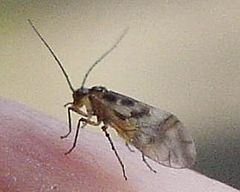Psocoptera facts for kids
Quick facts for kids PsocopteraTemporal range: Early Permian – Recent
|
|
|---|---|
 |
|
| adult barklouse | |
| Scientific classification | |
| Kingdom: | |
| Phylum: | |
| Class: | |
| Superorder: |
Psocodea
|
| Order: |
Psocoptera
|
| Suborders | |
|
|
Psocoptera are a group of small insects often called booklice, barklice, or barkflies. They have been around for a very long time, first appearing during the Permian period, which was about 295 to 248 million years ago!
Their name, Psocoptera, comes from ancient Greek words. Psokos means "gnawed" or "rubbed," and ptera means "wings." This name hints at how some of them might damage things by nibbling. There are over 5,500 different kinds, or species, of these insects known around the world.
Contents
What Are Psocoptera?
Psocoptera are tiny insects, usually measuring from 1 to 10 millimeters long. That's about the size of a grain of rice up to a small ant. Many of them have wings, but some types do not. They are often considered to be very old relatives of other insects like true bugs.
Booklice and Barklice: What's the Difference?
The common names "booklice" and "barklice" tell you a lot about where these insects live.
- Booklice are usually wingless and live indoors. You might find them in old books, damp cupboards, or food pantries. They are very small and often go unnoticed.
- Barklice usually have wings and live outdoors. They are found on the bark of trees and shrubs. They often live in groups, sometimes forming large colonies.
How Many Kinds Are There?
Scientists have found more than 5,500 different species of Psocoptera. These species are divided into three main groups, called suborders:
- Trogiomorpha
- Troctomorpha
- Psocomorpha
Each suborder contains many different families of these insects. New species are still being discovered and described by scientists even today!
Where Do Psocoptera Live?
Psocoptera are found all over the world, in many different environments.
- Outdoors: Barklice prefer damp, sheltered places on trees and shrubs. They often hide under loose bark, in leaf litter, or among moss and lichens. They are common in forests and gardens.
- Indoors: Booklice like places with high humidity. They can be found in homes, libraries, and museums. They often live in places where mold or mildew might grow, such as damp basements, bathrooms, or even inside old furniture.
What Do Psocoptera Eat?
Psocoptera are mostly scavengers, meaning they eat dead or decaying things. Their diet depends on where they live.
- Outdoor Psocoptera: Barklice mainly feed on algae, lichen, and fungi that grow on tree bark. They also eat dead plant material.
- Indoor Psocoptera: Booklice feed on microscopic mold and fungi that grow on damp surfaces. They can also eat starchy materials found in books, wallpaper glue, and stored food products like cereals. This is why they are sometimes found in pantries.
Life Cycle of Psocoptera
Psocoptera go through a simple life cycle called incomplete metamorphosis. This means they don't have a pupa stage like butterflies.
- Eggs: The female psocopteran lays tiny eggs, often in cracks or under bark. Some species cover their eggs with silk or debris for protection.
- Nymphs: When the eggs hatch, tiny young insects called nymphs emerge. Nymphs look like smaller versions of the adult, but without fully developed wings.
- Molting: As nymphs grow, they shed their outer skin several times. This process is called molting. Each time they molt, they get a little bigger and their wings develop more.
- Adults: After several molts, the nymphs become adult insects. Adults are ready to reproduce and continue the life cycle. The entire life cycle can take a few weeks to a few months, depending on the species and conditions.
See also
 In Spanish: Piojos de libros para niños
In Spanish: Piojos de libros para niños

